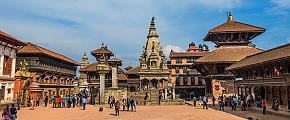[Nepal Travelogue] Expect the Unexpected
It's been two weeks since I returned from my one-week trip to Nepal, yet I am still unsure about what to start with the journal. Not because the memory has passed into oblivion but because words simply fail me to describe the overall fantastic experience in that Himalayan country.
- Mathilda Wu, Marketing Specialist at Odyssey Tours
We did a classic Nepal triangle trip of Kathmandu, Chitwan, and Pokhara. I must admit that all have their own charm that very few places can achieve at the same time. Read on, and you'll see why I have the nerve to say so.
Kathmandu
It is in Kathmandu that the saying "the first impression is a lasting impression" holds true for me. The city is massive, nestled in a green valley surrounded by enormous mountains. A quick drive from the airport to the town left me with amazement at the red-brick houses, people's smiling faces as well as roaming cattle and busy traffic - yes, it's like what you saw in a movie or that while things are more sophisticated when you are actually there!
Amid the swirling dust and dark fumes, we spotted a riot of colors on the street walls - murals depicting symbols, people, animals, and creative images for up to a stretch of more than a mile. We were told that street art is on the rise, as local and international artists are setting up projects in Nepal to send out messages of man-made beauty.
Nepal was never colonized. Before the unification in the 18th century, it was ruled by several kings, who built three splendid Durbar Squares as royal palaces, which all are now parts of the seven UNESCO World Heritage Sites in the Kathmandu Valley. The one we visited, Patan Durbar Square, is really impressive.
The peaceful palace courtyards contain various well-preserved pagodas and stone temples. Our private guide Kshitij did a good job explaining the functions of the beautiful wood carving, symbols, and ornaments. With his rich knowledge, the ancient site was brought to life. As we walked through, flocks of pigeons circled above the monuments, making a fascinating picture before us.
Perhaps due to the off-season, Durbar Squares are not so much touristy sites as where the locals watch the time away. We had the chance to interact with a group of college students who were taking a break. What they firmly believe in somewhat blew us: skill is more important than education in today's Nepal.
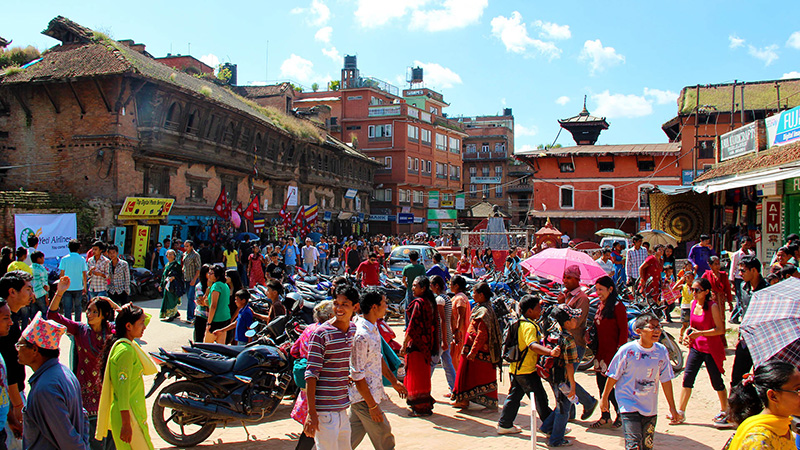 Durbar Squares, Kathmandu
Durbar Squares, Kathmandu
I was also struck by the fact that the Nepalis see death as an everyday experience when in Pashupatinath Temple, one of the seven UNESCO World Heritage Sites. The temple is a place where people bring the dead for outdoor cremation on the Bagmati River. Instead of feeling grisly, I found it rather calm. And most peculiarly, the family didn't mind our being here.
We ran into a few families holding memorial ceremonies for the deceased, such as making unique offerings and shaving the male relatives' hair.
Pashupatinath is where you encounter genuine sadhus dressed in colorful yellow and orange robes with ashes, long hair, and a beard. A photo opportunity with them is well worth a dollar spent.
Besides much history and culture, Kathmandu has earned its name for fantastic nightlife in Thamel, an active hub full of life, restaurants, shops, and live houses! The area is as safe as anywhere we went in Nepal. We saw many local people hang out here, so there is no way that you would feel as in a touristy place at all.
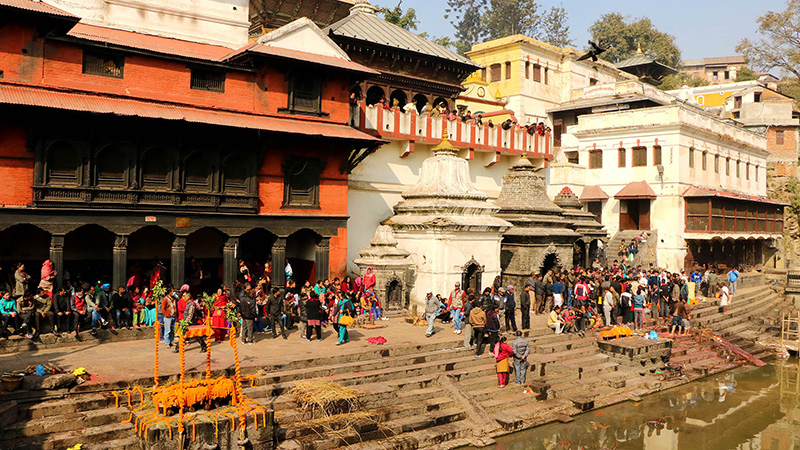 Pashupatinath Temple
Pashupatinath Temple
Chitwan
So this is where we explored the wild jungle. Here we got close to a number of wildlife, including a single-horned rhino, a couple of deer, wild boars, monkeys, and countless beautiful birds. Unfortunately, tigers haven’t been seen for decades.
Chitwan National Park covers a vast area and was once the royal family's hunting ground. Today it offers dozens of jungle activities, such as Jeep safari, canoeing, jungle walks, and cycling around the village. We were the only group that did a boat ride that afternoon – what a privilege to enjoy the whole tranquil view of the lake and the surroundings!
In short, Chitwan is a perfect place for physically active travelers to discover the undisturbed vestiges of wild species. The other perfect one we know is probably in South Africa (wink).
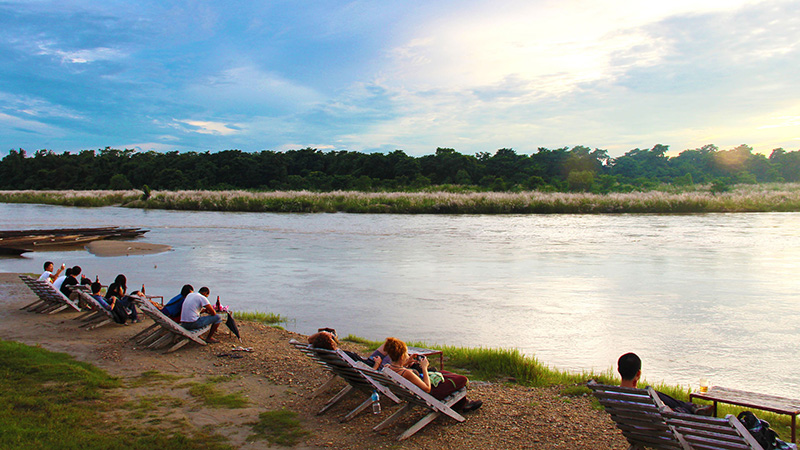 Chitwan National Park
Chitwan National Park
Pokhara
Oh boy - is there any place better than Pokhara in the world? It's not in my dictionary, anyway. Located around 200 km west of Kathmandu, Pokhara offers an entirely different picture from the populated capital: clean streets, snow mountains, a laid-back atmosphere, and adventure choices.
The center of the small city is dominated by the majestically beautiful Phewa Lake, from where we can get a clear view of the snow-capped mountains of the Annapurna range. Many lakeside hotels have rooms that you can see the range even from bed - ask your travel consultant to arrange one!
We stayed at Fishtail Lodge, which sits on a quiet peninsula of Phewa Lake. Getting to the lodge is dreamy as the 24-hour ferries and boats are the only access.
It seems you can't escape Annapurna no matter where you go in Pokhara, but we couldn’t get enough. An easy walk up to a hill where the World Peace Pagoda was built brought us a gorgeous view of the white ranges and the entire Pokhara. Simply mind-blowing.
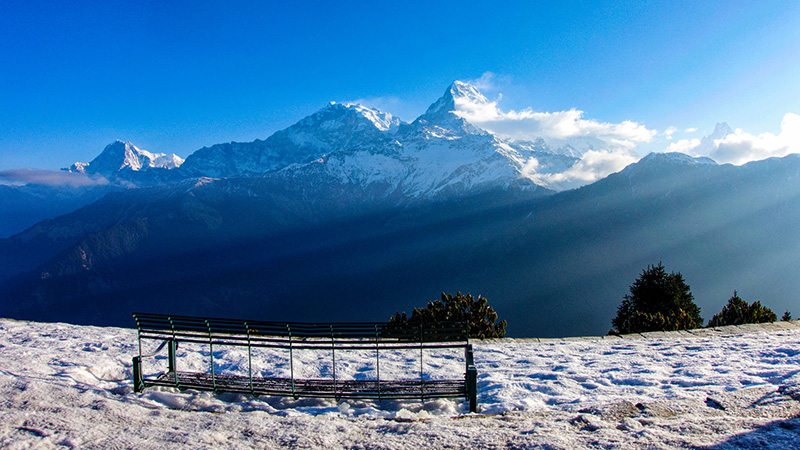 Stunning View in Pokhara
Stunning View in Pokhara
Many Tibetans came to live in Nepal in 1959. In Pokhara, we visited one of their settlements to experience the culture, history, and present. A middle-aged monk greeted us, and a few school girls fulfilled our wish for photos. Thanks:-) We didn’t have time to eat lunch with a local Tibetan family, which otherwise could have been one of the best memories.
In addition to trekking, Pokhara is arguably the world’s best paragliding venue, which we don’t doubt after a bold try. Soaring with birds with spectacular scenery is something I will never forget.
We spent the early morning of the last day in Pokhara at Sarangkot, a village known as the best place to watch the breathtaking sunrise across the Annapurna Himalaya. I could never believe sunrise could be that incredible before I went here. The snow-capped mountains were painted purple-pink to gold, and the whole valley downhill awoke as the sun slowly came out.
I almost cried when the departure was due. If possible, I would love to revisit in a heartbeat. Nepal is by no means a place you should avoid because of media hoaxes. And I am sure the Western visitors we stumbled into on the way will see eye to eye with us. “Nepal is so safe and beautiful that we couldn’t enjoy more,” they said.
A huge thank-you to those who will prove Nepal deserves their visit. Contact Odyssey Tours at trip@odynovotours.com if you would love to visit Nepal in a heartbeat!

